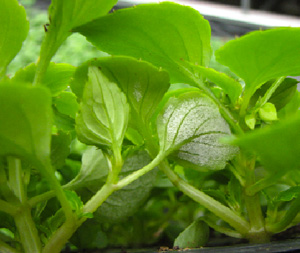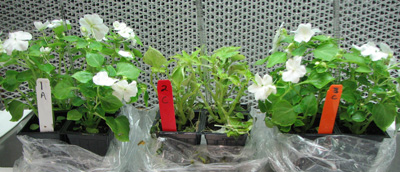12/21/2011
Downy Mildew of Impatiens
Dr. Colleen Y. Warfield

Impatiens downy mildew is a destructive foliar disease of
Impatiens walleriana. While there have been sporadic reports of this disease in production greenhouses in the United States since 2004, widespread regional outbreaks of impatiens downy mildew were observed for the first time in North American landscapes in 2011. Impatiens downy mildew was confirmed in landscape beds and container plantings on the central and southern coast of California, northeast Illinois, northern Indiana, the Twin Cities area of Minnesota, Cape Cod, Massachusetts, and Long Island and upstate New York. Unconfirmed cases of impatiens downy mildew were also reported in landscape beds in southern Wisconsin and the Niagara Falls region of Ontario, Canada. The incidence and distribution of this disease in North America may be even greater than realized due to unfamiliarity with the signs and symptoms of the disease, especially as seen in landscape settings.
Hosts
All varieties and intraspecific hybrids of
Impatiens walleriana are susceptible to impatiens downy mildew, including both vegetative- and seed-produced
I. walleriana. There are no marketable differences in susceptibility among varieties; however, research conducted by The Food and Environmental Research Agency (FERA) in the United Kingdom has shown no evidence of seed-borne transmission. A few species of wild impatiens are also hosts of this disease, but there are no other known hosts. New Guinea impatiens (
Impatiens hawkerii) are highly tolerant to this downy mildew and have been successfully grown in greenhouses and landscape beds even under high disease pressure for downy mildew.
Symptoms
Impatiens downy mildew symptoms begin as a light-green yellowing or stippling of infected leaves. Very subtle gray lines or markings are sometimes observed on the top of the leaf. Infected leaves may curl downward at the edges, but generally this is a more advanced symptom of infection. Young plants and immature plant tissues are especially susceptible to infection. As such, leaf symptoms are often first observed on the younger or terminal growth. Seedling cotyledons are also highly susceptible to infection. Plants infected at an early stage of development may be stunted in both height and leaf size, yet may show no visible signs of sporulation if environmental conditions are not favorable for disease expression.
A white, downy-like growth composed of spores may be visible on the underside of infected leaves under cool temperatures (about 60 to 73F/15 to 22C) and moist or humid conditions. When scouting, it is very important to turn leaves over to observe the undersides for this white growth. The time from infection to the appearance of symptoms varies from about five to 14 days depending on the age of plant tissue, temperature and humidity. The latent period between infection and visible plant symptoms is of concern because infected plants could potentially be shipped or moved without even knowing there is a disease problem. This highlights the importance of preventive control at both the production and young plant producer level to ensure cuttings and seed-produced plugs are kept free of this disease.
If the disease continues to progress, eventually the leaves and flowers will drop, resulting in bare stems with only a few tiny, yellow leaves remaining. This symptom is more likely to be observed in a landscape setting where symptoms and early signs of infection are more likely to go unnoticed, in comparison to a greenhouse setting where plants are frequently scouted and suspect plants would be quickly rogued.
Pathogen Biology
Impatiens downy mildew is caused by
Plasmopara obducens. This host-specific, fungus-like organism is known as an oomycete or water mold. Oomycetes, which include Pythium and Phytophthora, are some of the most destructive plant pathogens due, in part, to their swimming spores that thrive in wet conditions and can spread with alarming speed. These swimming spores (zoospores) are produced inside sac-like fungal structures called sporangia. The sporangia form on microscopic, treelike structures that are produced from a fungal mat inside the leaf tissue and emerge through the stomata on the underside of infected leaves. It is these spore-bearing structures that are responsible for the visible white, downy-like growth on the leaf underside. In response to changes in light, temperature and/or humidity, the sporangia are dislodged and can easily become airborne or splashed by rain or water to other leaves and distant plants. Zoospores released from the sporangia can swim in moisture on the leaf surface, encyst, then germinate and penetrate the leaf tissue through the stoma by means of a germ tube.
In addition to the zoospores produced in the aerial sporangia, another type of spore may form inside infected stems and leaves. These spores, called oospores, may survive in plant debris and be released into the soil as the stems decay. These resting spores can potentially survive in the soil for a period of years. Controlled experiments and observation of landscape beds have shown that impatiens planted into oospore-infested soil developed downy mildew. If
Plasmopara obducens behaves similarly to other Plasmopara species, the following season the oospores in the soil may be triggered to produce the same treelike, spore-bearing structures that are observed on the leaf undersides. These sporangia are then splashed by rain or carried by wind to cause new plant infections. These airborne spores may potentially find their way into greenhouses, serving as one potential source of inoculum.
Disease management
CULTURAL PRACTICES
Avoiding the introduction of diseased plant material is an important first step in managing downy mildew. The integrity of the supply source is an important component in minimizing the risk of introducing infected cuttings into a greenhouse facility. To help ensure a supply of healthy cuttings, downy mildew is managed very aggressively at the production level. While seed-raised impatiens are susceptible to downy mildew, there is no evidence of seed transmission. Therefore, vegetative cuttings and seed-grown plants should ideally be grown in separate houses to limit cross-contamination, especially given the potential for asymptomatic, latent infections. Because moisture favors the development of downy mildew, cultural controls should focus on reducing greenhouse humidity and limiting leaf moisture. Good air movement through plant spacing and horizontal air flow, adequate drainage and irrigating when leaves will dry most quickly will help to minimize leaf wetness and humidity. Avoiding high humidity and leaf wetness at night is especially important in limiting secondary infections.

From left to right: 1) a non-treated,
non-inoculated control; 2) a non-treated, inoculated control; and 3) a plant treated with fungicide (Adorn).
CHEMICAL CONTROL
Apply fungicides preventively for maximum efficacy. I’ve conducted a series of fungicide efficacy trials applying products both preventively, as well as three or six days after inoculation. The highest levels of control were always obtained when fungicides were applied preventively. Adorn, Fenstop, Heritage, Orvego, Pageant, Protect, Stature, Segway and Vital all provided very good to excellent control of impatiens downy mildew when applied as foliar sprays prior to inoculation in repeated trials. Adorn was tank mixed with Protect following label guidelines for managing fungicide resistance. Aliette, applied as a drench one day prior to inoculation, did not adequately control the pathogen and almost 50% of the leaves had visible sporulation within 13 days after inoculation. Subdue MAXX, applied as either a foliar spray or drench, was completely ineffective in controlling downy mildew using an isolate of P. obducens originally collected in Holland. However, excellent control was obtained when plants were drenched with Subdue MAXX prior to inoculation with downy mildew isolates collected in Illinois and California in 2011. This clearly demonstrates differences among downy mildew populations in their sensitivity to mefenoxam, and the importance of rotating between fungicides with different modes of action.
When fungicides were applied three days after inoculation, Adorn, Fenstop and Stature had the best efficacy of all products tested, providing good to very good control. With exception of Adorn, fungicides applied six days after inoculation, when sparse sporulation was just visible on a few leaves, reduced the severity of the disease but at levels that would not be acceptable in a production facility. Adorn provided very good control even when applied six days after inoculation, and was as equally effective as a foliar spray or drench.
It is critical to follow all label directions and guidelines for managing fungicide resistance, and make sure you are rotating among fungicides with different modes of action (refer to FRAC code). Editor's note: See table on page 56 for FRAC codes and a list of active ingredients for the fungicides mentioned.
SCOUTING
Frequent scouting of the crop, paying particular attention to early leaf symptoms (subtle stippling or yellowing), is critical for early detection. Symptomatic plants and any fallen leaves or petals should be promptly bagged and sealed before carrying out of the greenhouse. Avoid placing infected plants into the compost pile.
GT
Dr. Colleen Y. Warfield is corporate plant pathologist for Ball Horticultural Company in West Chicago, Illinois. She can be reached at cwarfield@ballhort.com.